Non-isolated DC/DC topology, such as buck, boost, and buck-boost, shares the common wire connection from the input to output. For example, a buck converter, as shown in Fig. 3.7, cannot prevent high voltage from the source passing to the load in case of a short-circuit failure of the active switch. Galvanic isolated converters provide full dielectric isolation between input and output circuits. Electric codes and regulations require galvanic isolation in certain applications to improve safety and reliability. A voltage transformer can provide isolation by way of magnetic induction, which is also capable of transmitting electricity. Power transformers are classified by their operating frequencies, e.g., line frequency (LF), medium frequency (MF), and high frequency (HF). LF transformers rated for either 50 or 60 Hz are widely utilized in power networks. Modern power electronics tends to MF or HF transformers, showing the advantages of low winding turns, small size, light weight, and low cost. The HF application is the driving force to design and produce compact power supplies and converters for consumer and industry applications. Digital consumer devices have increased significantly in the past years, which should be directly powered by DC. A personal computer (PC) usually is supplied by the switching-mode power supply rated from 200 W to 1 kW. It is also termed the offline power supply. Figure 7.1 shows a typical system diagram, which represents a typical ATX power supply for desktop PCs. The device provides multiple DC outputs covering the voltage ratings of 12, 5, and 3.3 V. The important components include the electromagnetic interference filter, rectifier converting single-phase AC to DC, active power factor correction (PFC) unit, and the multiple-output DC/DC converter. The DC/DC converter shall include the function of galvanic isolation for safety purpose. The utilization of an isolation transformer can support multiple windings for different voltage levels as the outputs, as illustrated in Fig. 7.1. FIGURE 7.1 System diagram of DC power supplies for PC. The switching-mode power transformers are mainly used for HF operation, which follows the same principle and configuration byways of the multiple-windings and linkage of the magnetic field. The mode of operation makes the term differ from the conventional power transformer and creates a variety of designs and optimizations. The characteristics of a typical magnetic core is illustrated by the B-H curve discussed in Sec. 1.8. The switching operation can make the magnetic flux swings in only one quadrant based on the linearized B-H curve, as highlighted in Fig. 7.2a. Inductors commonly operate the magnetic field in one quadrant region. However, the inductive coupling can be utilized for power transformation in DC/DC conversion topologies. Same as a transformer, electrical power can pass from one winding to another through electromagnetic induction. Such utilization is often called the coupled inductor to distinguish from the standard power transformer. The inductance and energy storage capability play the important roles in applications. The topologies of flyback and forward converters are based on such this operation since the magnetic current is modulated on one polarity region, similar to the concept of inductors. The magnetic field flux density can vary up and down but maintain a unipolar direction. A classification of isolated DC/DC converters can be based on the operating region of the B-H curve, as shown in Fig. 7.3. FIGURE 7.2 B-H curves of magnetic cores of operational zone: (a) one quadrant; (b) two quadrants. FIGURE 7.3 Classification of isolated DC/DC converters. Another isolated DC/DC group includes the topologies of push-pull, full bridge, and half bridge, as shown in Fig. 7.3. The isolation transformer allows flux to swing two quadrants of the linearized B-H curve, as highlighted in Fig. 7.2b. The two-quadrant definition follows the piecewise linear approximation of the B-H curve. The magnetic current becomes AC showing the positive and negative cycles, which follow the concept of traditional power transformers. The magnetic field is considered more optimally utilized than the single-quadrant solution. The forward converter is classified in the same group as the flyback converter in terms of the operational quadrant of magnetics. It also belongs to another group of topologies called the buck-derived converters since the operational principle closely follows the nonisolated buck converters. The flyback converter is special since it is derived from the buck-boost topology. Depending on the size and design, a magnetic core can handle a certain amount of magnetic flux density. When the maximum flux density is reached, the permeability of the core significantly reduces, as illustrated in Fig. 7.2. Core saturation makes the inductors or transformers deviate from the specified inductance and lead to a magnetic current shooting in amplitude. Thus, an inductor or transformer should be adequately sized and designed to be away from the saturated magnetization. Besides the characteristics of the core material and size, the consideration also includes the applied voltage and frequency. Saturation state can be detected by monitoring the magnetizing current. The current shall increase following the predesigned inductance and the applied voltage. When a sudden increase in current is detected in steady state, the saturation happens. The magnetic flux is expressed in (7.1), which leads to the expression of the flux density in (7.2). The symbols refer to the same variables discussed in Sec. 1.8.1. When an inductor or transformer is constructed, the over-limit of B(t) results from any excessively applied “voltage × seconds.” The maximum value of the flux density, Bmax, is given in magnetic core datasheets for the design consideration to avoid saturation. Flyback converters are widely used for the low-power DC/DC conversion, which support galvanic isolation and high conversion ratio of voltage. The flyback topology is used to supply a wide range of electronic devices. The flyback converter is usually considered the simplest isolated topology that can convert the voltage from the distributed level to 5 V. Such low-power switch-mode power supplies are mainly used to supply portable electronics, e.g., cell phones and tablets. Higher capacity units are applied for the power supplies of personal computers. Recently, the flyback topology is also used in solar PV systems to step up the voltage from the low level of a single PV module to the level suitable for grid interconnection. The flyback converter is derived from the nonisolated buck-boost topology. The operation of a buck-boost converter has already been explained: energy is stored in the inductor during the on-state of the active switch; flyback operation happens when the active switch is turned off for a specific time to release the prestored magnetic energy. The inductor current naturally forces the designed circuit to release the stored energy from the magnetic field to the load. Figure 7.4 illustrates the evolution from the nonisolated converter to the flyback topology with galvanic isolation. The development from the buck-boost converter to the flyback topology can be described as follows: FIGURE 7.4 Evolution into flyback converter from buck-boost topology. • The first step is the transition from the standard buck-boost converter, as shown in Fig. 7.4a,b, by changing the single-winding inductor into a two-winding inductor. • The galvanic isolation can be added by separating the windings and creating an isolated two-winding inductor, as illustrated in Fig. 7.4c. • The final transition creates the standard form of the flyback converter, as shown in Fig. 7.4d, by manipulating the dot notation to normalize polarity and realize the low-side switch for driver and control. The winding turns ratio can also be applied to make the voltage conversion flexible. Conventional voltage transformers provide the magnetic path that instantaneously passes AC from the primary winding to others. The flyback transformer follows the same configuration that a couple of coils share a common core and transmit power from one to another. However, the operational concept is different from the function of the conventional voltage transformer. The magnetic field of the flyback transformer follows the one-quadrant operation, the same as the inductor in buck-boost topologies. Thus, it is mostly called a coupled inductor due to the short-term energy storage during the steady-state operation. Figure 7.5 shows the fundamental circuit of a flyback converter, which includes one active and one passive switch. The transformer design follows two aspects, including the winding turns ratios shown by 1:n and the magnetizing inductance, L. Figure 7.6a illustrates the equivalent circuit when Q is on-state. An amount of energy should be stored in the magnetic field via the primary winding connection with the power source. The letter L refers to the magnetizing inductance crossing the primary winding during the on-state. The value of L determines the increase in rate of the iQ. The diode is oriented to block current flow from the flyback transformer to the load side. The duration of the on-state determines the amount of energy stored. FIGURE 7.5 Circuit of flyback converter with winding turns ratio 1:n. FIGURE 7.6 Equivalent circuits of flyback converter at (a) on-state; (b) off-state. The flyback stage becomes active when Q is turned off; the equivalent circuit is shown in Fig. 7.6b. The current path through the primary winding is broken at the moment of turning off. The sudden change induces a reverse voltage of vL. The voltage appearing at the secondary winding forces the diode forward-biased. The off-state releases the pre-stored energy in L through the secondary winding and supplies to the load and charge the capacitor. In summary, the energy transferred through the flyback transformer shows an asynchronous pattern in every switching cycle, which is based on the same principle as the inductor used in buck-boost converters. The inductor current, iL, is defined to represent the current through L. The steady-state analysis of the flyback converter can be applied and based on the inductor current, iL, as shown in Fig. 7.7. In a steady state, the stored energy in L during the on-state shall be equal to the released value in the off-state of Q. The averaging value of iL becomes constant; therefore, the rising and dropping amplitudes of the inductor current is equal to the magnitude, ΔIL, as indicated in Fig. 7.7. During the on-state, the inductor current is equal to the current through Q, iQ, which can be sensed. The increasing amplitude of the inductor current is expressed by (7.3) during the on-state period, TON. Figure 7.7 shows that vL = Vin and iQ = iL. FIGURE 7.7 Steady-state waveforms of flyback converter in CCM. During the off-state of Q, the flyback transformer is disconnected from the power source. The flyback effect releases the stored power in L to the load via the secondary winding and the forward-biased diode. Following the equivalent circuit in Fig. 7.6b and the steady-state waveforms in Fig. 7.7, the dropping amplitude can be determined by (7.4) where TDOWN indicates the period that iL is decreasing. During the off-state, the inductor current cannot be directly measured but can be inferred from the measurement of the diode current since where VO is the steady-state voltage crossing the load. The steady-state condition shows that the peak-to-peak level of the inductor current ripples is constant. Combining (7.3) and (7.4) leads to the voltage conversion ratio: According to Fig. 7.7, the continuous conduction mode (CCM) can be mathematically expressed by TDOWN = TOFF and TON + TDOWN = TSW, where TSW is the period of one switching cycle. In the CCM, the voltage conversion can be expressed by where In the discontinuous conduction mode (DCM), the inductor current is saturated at the zero levels for a certain time period (TZERO) in each switching cycle during a steady state. The DCM happens when the prestored energy completely releases before the end of the off-state of Q. The zero-state shows iL = 0 and iD = 0, as shown in Fig. 7.8a, when both Q and D are off-state. The steady-state waveforms of vL, iL, and iQ are shown in Fig. 7.8b. The DCM condition is mathematically expressed by TZERO > 0, TUP + TDOWN ± TSW, or FIGURE 7.8 DCM illustration of flyback converter: (a) zero-state; (b) steady-state waveforms. The averaging value of iQ can be derived by (7.8) by following (7.7) and the waveforms shown in Fig. 7.8b. In a steady state, the power balance from the input port to the output port can be expressed by (7.9) without considering power loss. Combining (7.8) and (7.9), the voltage conversion ratio in the steady state and the DCM can be derived as shown in (7.10), where the load resistance, R, is considered. The boundary condition mode (BCM) refers to the critical condition between the CCM and the DCM. The condition is mathematically defined by (7.11). The steady-state analysis follows the same as the CCM, which shows the conversion ratio as in (7.6). The averaged value of iD can be identified by (7.12). The critical load can be derived by the equivalence of AVG(iD) ≡ AVG(io) in steady state and determined by (7.13). The operation enters the DCM when the load condition becomes R > Rcrit. A flyback converter is utilized to achieve the high step-down voltage conversion and supply 5-V DC to USB-powered loads. The design of flyback converters at the CCM can follow the following sequence: 1. Decide the winding turns ratio to make DON close to 50% with the consideration of the ratio of the input voltage and output voltage in the nominal condition. 2. Calculate on-state duty cycle and on-state time in steady state: 3. Calculate the inductance: 4. Calculate the capacitance: 5. Determine the BCM in terms of the averaged output current and the resistance. The specifications for the DC/DC stage are listed in Table 7.1. The input voltage, Vin, is referred to the nominal condition of the averaged value of vdc in the circuit schematics. Based on the specification and proposed design process, the following parameters are determined: TABLE 7.1 Specifications of Flyback Converter 1. The winding turns ratio is assigned to be n = 0.02 since the voltage conversion is from 300 to 5 V. 2. On-state duty cycle at the CCM: 3. Calculate the inductance: 4. The power rating shows that the output current IO = Pnorm/VO = 3 A; CO = 5. Critical load condition: Developing simulation model follows the schematics in Fig. 7.5 and the switching mechanism. When Q is on-state, the system dynamics can be represented in (7.14). When Q is off-state, the system dynamics can be expressed by (7.15). Based on the on/off states and the related dynamics, a Simulink model can be built, as shown in Fig. 7.9. The model follows an ideal flyback converter, which neglects power losses. The modeling is similar to the nonisolated buck-boost converter, except for the winding turns ratio and the polarity of the output voltage. The model includes three inputs, which are the pulse width modulation (PWM) command signal for the switches, the input voltage (Vin), and the output current (io). The value of io depends on the variation of load resistance (R) and the applied voltage (vo). It outputs two signals, which are the inductor current (iL) and the output voltage (vo). The saturation sign is included in the integration blocks, which constraints the inductor current (iL) and output voltage (vo) to be always positive. The implementation can support the zero-state of the DCM when iL is saturated to zero. FIGURE 7.9 Simulink model of flyback converters. Figure 7.10 demonstrates the simulated waveforms of iL and vo, which responded to the 45.45% on-state duty. The steady-state waveforms show that the averaged values of vo and iL are 5 V and 0.11 A, respectively. The simulation results agree with the converter specification in terms of the nominal output voltage and power. The load resistance is 1.67 Ω, according to the nominal operating condition. The zoom-in plots shown in Fig. 7.11 reveal the peak-to-peak ripple of iL and vo. The simulation results show that ΔIL ≈ 20 mA and ΔVO ≈ 50 mV, which is the same as specified in Table 7.1. FIGURE 7.10 Simulation results of the nominal operation (R = 1.67 Ω). FIGURE 7.11 Simulation results of the nominal operation for ripple check. When R = Rcrit = 18.33 Ω, the operation enters the critical condition of the BCM. Simulation verifies the operating condition by assigning the load resistance to Rcrit. Figure 7.12 illustrates the boundary steady state between the CCM and the DCM. When R = 37 Ω, higher than Rcrit, the operation enters the DCM. According to (7.10), the output voltage in steady state should be 7.10 V when the on-state duty of 45.45% is applied. This can be verified by the time-domain simulation, as shown in Fig. 7.13. The zero-state in each switching cycle is noticeable in the discontinuous waveform of iL. FIGURE 7.12 Simulation results of the BCM operation (R = 18.33 Ω). FIGURE 7.13 Simulation results of the DCM operation (R = 37 Ω). The forward converter shows another example of the one-quadrant operation of the B-H curve in the magnetic field. It is well-known in competition with the flyback topology. Different from the flyback topology, the on-state of the power switches in a forward converter transfers power from the source to the load. The discussion starts with the two-end-switching forward converter, in which the operational principle is easy to understand. One-end-switching, or one-transistor topology, which follows the same operational principle, will also be discussed. Figure 7.14 shows the two-end-switching forward converter. The topology applies power semiconductor switches at both ends of the primary winding. The power train circuit of the right side is the same as a nonisolated buck converter.
CHAPTER 7

Isolated DC/DC Conversion

7.1 Region of Magnetic Field
7.1.1 Operational Quadrant and Classification

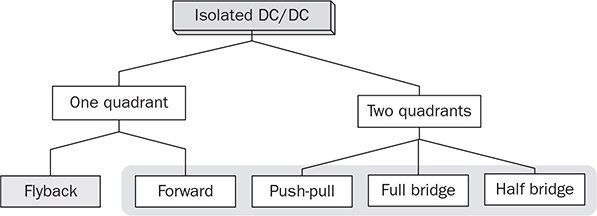
7.1.2 Critical Checkpoint for Saturation


7.2 Flyback Topology
7.2.1 Derivation from Buck-Boost Converter
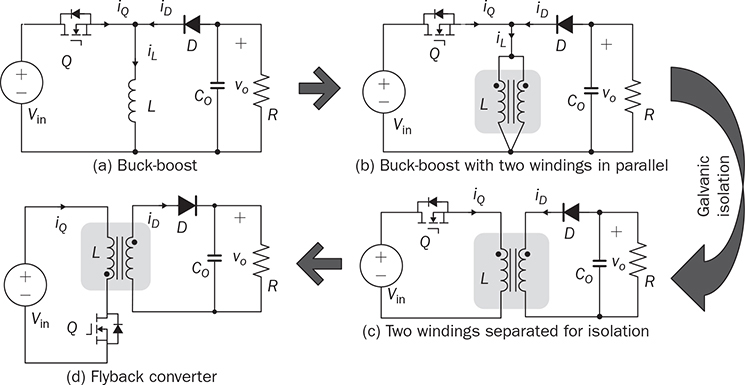
7.2.2 Flyback Operation
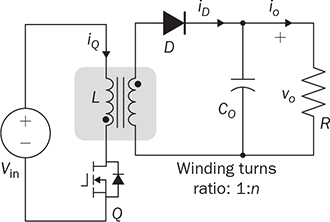
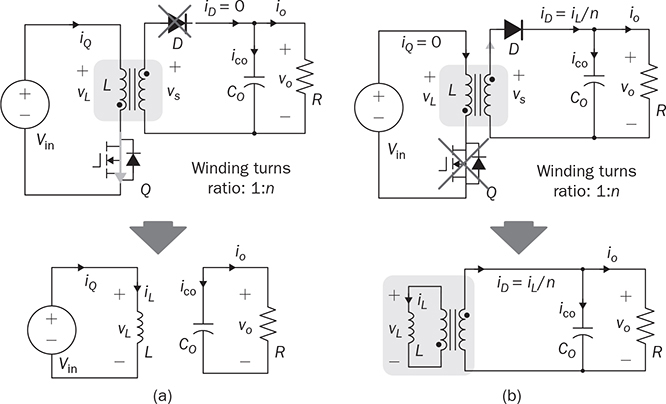
7.2.3 Continuous Conduction Mode
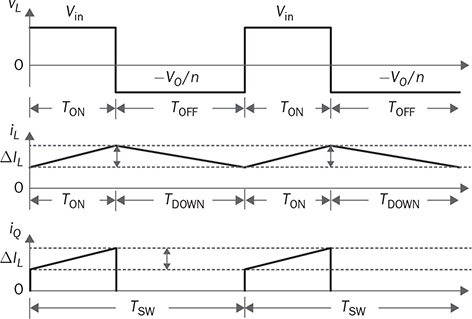

 and
and  .
.



 and DOFF = − DON.
and DOFF = − DON.
7.2.4 Discontinuous Conduction Mode
 . The voltage conversion ratio at DCM follows the same derivation from (7.3) into (7.5). However, TDOWN cannot be directly determined by the difference between TSW and TON due to the unknown value of TZERO. In the DCM, TON is the control variable and is known for the following analysis. The ripple current of iL can be determined by
. The voltage conversion ratio at DCM follows the same derivation from (7.3) into (7.5). However, TDOWN cannot be directly determined by the difference between TSW and TON due to the unknown value of TZERO. In the DCM, TON is the control variable and is known for the following analysis. The ripple current of iL can be determined by
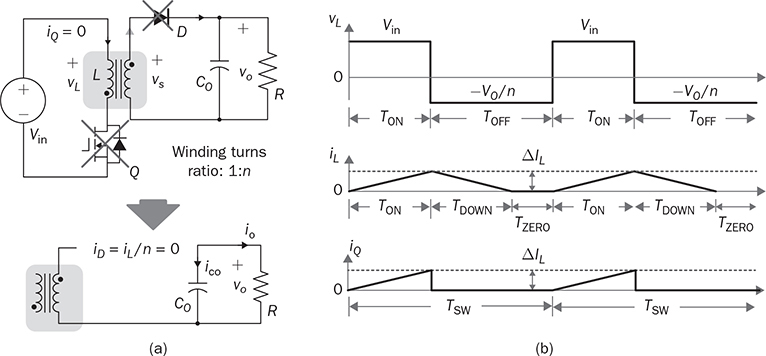







7.2.5 Circuit Specification and Design
 and
and  .
.
 derived by (7.3).
derived by (7.3).
 or
or  derived from the amplitude of the voltage drop at the on-state.
derived from the amplitude of the voltage drop at the on-state.
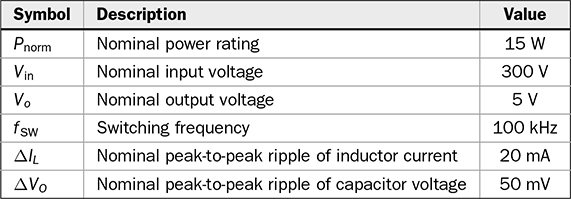

 4.545 μs.
4.545 μs.
 .
.
 .
.


7.2.6 Simulation for Concept Proof






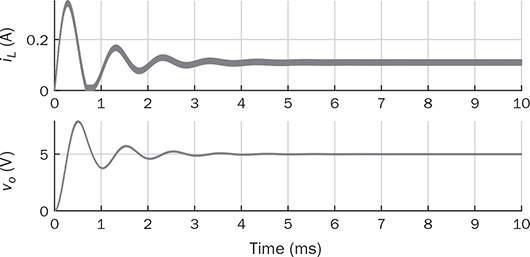
7.3 Forward Converter
7.3.1 Two-End-Switching Topology